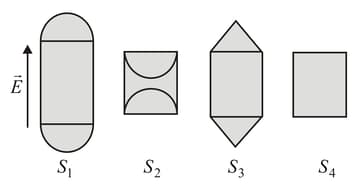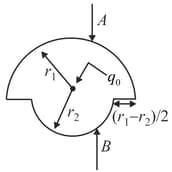The figure shows a point charge of at the centre of a spherical cavity of radius of a piece of metal. The electric field at,



Important Questions on Electric Flux and Gauss's Law
A right circular imaginary cone is shown in the figure. and are the points in the plane containing the base of the cone, while is the point at the vertex of the cone. If and represent the flux through the curved surface of the cone when a point charge is at points and respectively, then

, and are three large, parallel conducting plates, placed horizontally. and are rightly fixed and earthed (figure). is given some charge. Under electrostatic and gravitational forces, maybe

An insulating spherical shell of uniform surface charge density is cut into two parts and placed at a distance apart as shown in figure. and denote the electric fields at and respectively. As (i.e., )

The figure shows, in cross-section, two Gaussian spheres and two Gaussian cubes that are centered on a positively charged particle. Rank greatest first, and indicate whether the magnitudes are uniform or variable along each surface.

The figure shows four Gaussian surfaces consisting of identical cylindrical midsections but different end caps. The surfaces are in a uniform electric field that is directed parallel to the central axis of each cylindrical midsection. The end caps have these shapes: , convex hemispheres; , concave hemispheres; , cones; , flat disks. Rank the surfaces according to the net electric flux through them and the electric flux through the top end caps, the greatest first.

The figure shows a neutral metallic sphere with a point charge placed near its surface. Electrostatic equilibrium conditions exist on the metallic sphere. Mark the correct statements.

and are semi-spherical surfaces of radius and with and as the electric fields at their surfaces. Charge is placed as shown. What is the condition which may be satisfied?

